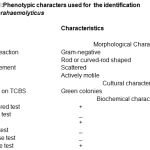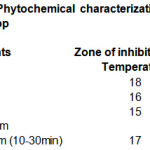Manuscript accepted on :April 12, 2011
Published online on: 28-11-2015
Plagiarism Check: Yes
S. Priya*, S. Santhiya and B. Jancy
P.G. Department of Biotechnology, S.T.E.T.Women’s College, Mannargudi - 614 001 India.
Abstract
Vibrios are the most common genera associated with crustaceans. The genus Vibrio were isolated from marine prawn (Penaeus monodon). The isolates were screened for vibriocin production. The best producer was identified as Vibrio parahaemolyticus .The maximum production of Vibrio spp. was manifested at 37ºC at pH 9, after 20h of incubation. The Vibrio spp. was confirmed by the presence of biochemical tests methyl red, VP and oxidase test. Its activity was enhanced in the presence of TCBS medium and withstands autoclaving temperature and showed activity even after prolonged chloroform treatment.
Keywords
Vibriocin; marine prawn; biochemical key
Download this article as:| Copy the following to cite this article: Priya S, Santhiya S, Jancy B. Vibriocin Production by Marine Prawn Associated Vibrio spp. Biomed Pharmacol J 2011;4(1) |
| Copy the following to cite this URL: Priya S, Santhiya S, Jancy B. Vibriocin Production by Marine Prawn Associated Vibrio spp. Biomed Pharmacol J 2011;4(1). Available from: http://biomedpharmajournal.org/?p=1909 |
Introduction
Aquaculture is an emerging industrial sector which requires continued research with scientific and technical developments and innovation (Faruque and Nair, 2003). Vibriocin are a group of bacteriocin produced and active against gram-negative bacteria in the genus Vibrio. They are curved shaped motile organism with single polar flagella (Thompson at al., 2004). Vibrios constitute one of the most common bacteria in surface waters. They are ubiquitous in the aquatic environment and are commonly present or a shellfish and other sea food. Vibrio are non-invasive pathogens, they cause some of the most serious cases of diarrhea in humans. These waterborne organisms are transmitted to humans via infected water or through fecal transmission (Chythanya et al., 2002).The present study report the production of vibriocin in marine prawn Penaeus monodon associated Vibrio spp.
Material and Methods
Sample collection
Marine prawn samples Penaeus monodon were collected from Nagappatinam District, Tamil Nadu, and East Coast of India. The samples were taken into sterile bags, kept in ice transport to the laboratory.
Identification of Vibrio species
Gut region of prawn sample was dissected and the suspended in 100ml of saline. Samples were taken from the suspension were serially diluted and plated on TCBS medium agar to get isolated colonies. From the TCBS medium, the green colonies isolated were selected and identified by gram staining.
Screening for vibriocin production
Vibrio isolates were grown in LB broth and inoculated at 37ºC for 24h. The cells were dissected and the supernatant fluid was overlaid with 3mL soft agar containing 1×106 cells of indicator organisms. Wells (5mm diameter) were cut and 100µL of supernatant fluid of the test organism were poured into each well. Next day zone of inhibition was measured (Godic and Bagovic,2003).
Choice of better producer
The Vibrio strains were screened for vibriocin production against the organisms. Since the strain Vibrio parahaemolyticus was manifesting the largest zone of inhibition, hence selected for detailed studies.
Biochemical and Physio-chemical characterization
The isolates were identified at the species level with theuse of biochemical tests (Manero and Blanch, 1999). To check the thermal stability, the V.parahaemolyticus was exposed to 60ºC (60 min), 100ºC (20 min) and 121ºC (15 min) and activity was checked by agar –well diffusion method. To observe the effect of chloroform on the vibriocin activity 24h old culture were exposed to chloroform vapours for 10-30min, overlaid with sensitive cells and then next day zone size was measured (Ahmed and Rasool,2003).
Results and Discussion
Vibrio strain growed on TCBS media and give green colour colonies isolated from the gut region of Penaeus monodon prawn. In order to identify the producer strain series of morphological and cultural tests were done as given in table-1.
 |
Table 1: Phenotypic characters used for the identification of V.parahaemolyticus.
|
The Vibrio strains were screened for vibriocin production by agar-well diffusion method. Carraturo et al (2006) reported that out of forty five halophilic Vibrio spp. (screened for antimicrobial production) only one strain i.e. V.mediterranei showed antimicrobial activity.
From the present study, the biochemical characteristics Vibrio species was tested and showed in table-1.This confirmed the presence of the Vibrio starin. Telesmanich et al (2000) reported that vibriocin produced by V.cholerae on 01 strain P-11702 was inhibitory to many gram-bacteria including S.flexneri, S.sonnei, V.cholerae and E.coli strain.
Vibriocin production was subjected to different heat treatments and consequently was found to be thermostable. V.parahaemolyticus was found stable at autoclaving temperature (121ºC, 15 psi for 15min) table-2. Earlier study, Parasad et al (2005) worked on a novel BLIS from a pathogenic strain of V.harveyi and found it stable at 60ºC for 10min.V.parahaemolyticus was found resistant to chloroform. Further there was no increase or decrease in the activity of the vibriocin of the chloroform treatment.
 |
Table 2: Phytochemical characterization of Vibrio spp.
|
Present study reports the ability of V.parahaemolyticus to produce a vibriocin inhibitory against the human pathogens. The properties of resistance to wide range of temperature, stability in the presence of chloroform vapours and production in different physiological conditions suggest, its potential application in food and medical microbiology.
References
- Ahmad, S. and Rasool, S.A. Isolation and biochemical characterization on mutacin VSM43 isolated from human oral Streptococcus mutans VSM43.Pak.J.Pharm.Sci., 16: 34-37 (2003).
- Carraturo, A., Raieta. K. and Russo, G.L. Inhibition of Vibrio parahaemolyticus by a bacteriocin like inhibitory substance produced by V.mediterranei 1.J.App.Microbiol., 101(1): 234-237(2006).
- Chythanya, R., Karunasagar.I. and Ugelstad, L. Inhibition of shrimp pathogenic Vibrios by a marine Pseudomonas I-2 strain. Aquaculture, 208: 1-10 (2002).
- Faruque, S.M. and Nair, G.B. Vibrio cholera: Genomics and molecular biology. Caister Academic Press, P.218 (2008).
- Godic, T.K. and Bogovic, B.M. Bacteriocins produced by B.cereus from milk. Food Tech. Biotech.,41(2): 121-129 (2003).
- Manero, A. and blanch, A.R. Identification of Enterococcus species with a biochemical key. App.Environ.Micro., 65(10): 4425-4430 (1999).
- Parasad.S., Peter,C.M., Hansen.H and Austin,B.A novel bacteriocin-like inhibitory substance from a pathogenic strain of V.harveyi in raw oysters. J.Food Micro., 69(8): 1829-1834 (2006).
- Telesmanich,N.P., Vinokur, N.L. and Nepomanishchaia, N.B. Bactericidal properties of hemo-cytolysin from V.cholerae non P-11702 strain in a panel of indicator culture for identification of vibriocin. Zh.Microbiol.Epidermiol.Immunolo., 6: 74-79 (2000).
- Thompson,F.L., Iid,T. and Swings, J. Biodiversity of Vibrios. Micro.and Molecular Biol.,68(3):403-409 (2004).







